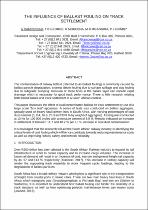JavaScript is disabled for your browser. Some features of this site may not work without it.
- ResearchSpace
- →
- Research Publications/Outputs
- →
- Conference Publications
- →
- View Item
| dc.contributor.author |
Rampersad, Ashiel

|
|
| dc.contributor.author |
George, Theresa B

|
|
| dc.contributor.author |
Mokoena, Refiloe

|
|
| dc.contributor.author |
Mgangira, Martin B

|
|
| dc.contributor.author |
Gräbe, PJ

|
|
| dc.date.accessioned | 2021-06-25T08:23:36Z | |
| dc.date.available | 2021-06-25T08:23:36Z | |
| dc.date.issued | 2018-07 | |
| dc.identifier.citation | Rampersad, A., George, T.B., Mokoena, R., Mgangira, M.B. & Gräbe, P. 2018. The influence of ballast fouling on track settlement. http://hdl.handle.net/10204/12033 . | en_ZA |
| dc.identifier.uri | http://www.satc.org.za/assets/final-announcement-brochure-and-programme-2018-8.pdf | |
| dc.identifier.uri | http://hdl.handle.net/10204/12033 | |
| dc.description.abstract | The contamination of railway ballast (referred to as ballast fouling) is commonly caused by ballast particle degradation, external debris fouling due to surface spillage and clay fouling due to subgrade pumping. Intrusion of these fines in the ballast layer can impede rapid drainage which is necessary for good track performance. There is little research relating both fouled ballast and track settlement in a South African context. This paper discusses the effect of coal contaminated ballast on track settlement by use of a large scale “box test” apparatus. A series of tests was conducted on ballast aggregate, typically used on heavy haul railway lines in South Africa, with varying percentages of coal dust material (0, 8.4, 16.9, 25.3 and 33.8 % by weight of aggregate). Testing was conducted at 10 Hz for 100 000 cycles with a moisture content of 5.0 %. Results indicated an increase in settlement of between 11.7 and 40.2 % per 10 % increase in coal dust contamination. It is envisaged that this research will aid the South African railway industry in identifying the critical levels of coal fouling which will hence contribute towards reducing maintenance costs as well as improving railway safety and network reliability. | en_US |
| dc.format | Fulltext | en_US |
| dc.language.iso | en | en_US |
| dc.relation.uri | http://www.satc.org.za/assets/final-announcement-brochure-and-programme-2018-8.pdf | en_US |
| dc.source | Southern African Transport Conference (SATC 2018), CSIR ICC Pretoria, South Africa, 9-12 July 2018 | en_US |
| dc.subject | Ballast | en_US |
| dc.subject | Fouling | en_US |
| dc.subject | Track settlement | en_US |
| dc.title | The influence of ballast fouling on track settlement | en_US |
| dc.type | Conference Presentation | en_US |
| dc.description.pages | 508-520 | en_US |
| dc.description.note | Paper presented at the Southern African Transport Conference (SATC 2018), CSIR ICC Pretoria, South Africa, 9-12 July 2018 | en_US |
| dc.description.cluster | Built Environment | |
| dc.description.impactarea | Transport Infrastructure Engineering | en_US |
| dc.identifier.apacitation | Rampersad, A., George, T. B., Mokoena, R., Mgangira, M. B., & Gräbe, P. (2018). The influence of ballast fouling on track settlement. http://hdl.handle.net/10204/12033 | en_ZA |
| dc.identifier.chicagocitation | Rampersad, Ashiel, Theresa B George, Refiloe Mokoena, Martin B Mgangira, and PJ Gräbe. "The influence of ballast fouling on track settlement." <i>Southern African Transport Conference (SATC 2018), CSIR ICC Pretoria, South Africa, 9-12 July 2018</i> (2018): http://hdl.handle.net/10204/12033 | en_ZA |
| dc.identifier.vancouvercitation | Rampersad A, George TB, Mokoena R, Mgangira MB, Gräbe P, The influence of ballast fouling on track settlement; 2018. http://hdl.handle.net/10204/12033 . | en_ZA |
| dc.identifier.ris | TY - Conference Presentation AU - Rampersad, Ashiel AU - George, Theresa B AU - Mokoena, Refiloe AU - Mgangira, Martin B AU - Gräbe, PJ AB - The contamination of railway ballast (referred to as ballast fouling) is commonly caused by ballast particle degradation, external debris fouling due to surface spillage and clay fouling due to subgrade pumping. Intrusion of these fines in the ballast layer can impede rapid drainage which is necessary for good track performance. There is little research relating both fouled ballast and track settlement in a South African context. This paper discusses the effect of coal contaminated ballast on track settlement by use of a large scale “box test” apparatus. A series of tests was conducted on ballast aggregate, typically used on heavy haul railway lines in South Africa, with varying percentages of coal dust material (0, 8.4, 16.9, 25.3 and 33.8 % by weight of aggregate). Testing was conducted at 10 Hz for 100 000 cycles with a moisture content of 5.0 %. Results indicated an increase in settlement of between 11.7 and 40.2 % per 10 % increase in coal dust contamination. It is envisaged that this research will aid the South African railway industry in identifying the critical levels of coal fouling which will hence contribute towards reducing maintenance costs as well as improving railway safety and network reliability. DA - 2018-07 DB - ResearchSpace DP - CSIR J1 - Southern African Transport Conference (SATC 2018), CSIR ICC Pretoria, South Africa, 9-12 July 2018 KW - Ballast KW - Fouling KW - Track settlement LK - https://researchspace.csir.co.za PY - 2018 T1 - The influence of ballast fouling on track settlement TI - The influence of ballast fouling on track settlement UR - http://hdl.handle.net/10204/12033 ER - | en_ZA |
| dc.identifier.worklist | 22481 | en_US |






